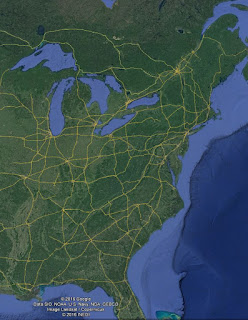As
archaeologists, we are often asked to describe the best or oldest artifact we
have found. People want to see the nicest point or the complete pot. But
sometimes the small and insignificant objects can also give us important
information on the people who have come before us. Two such objects are buckles
and buttons. These objects mean little to us in today’s world, other than as
functional items to hold our clothing together, but in the 18th
century buckles and buttons were symbols of wealth and status.
First
we will look at buckles, which were the primary type of fastener for both shoes
and clothing through most of the 18th century. Metal buckles were
largely produced in England and exported to America to be sold, although a small
number of buckles were made by local silversmiths and clockmakers. Buckle
frames were made most commonly of copper alloys, tin, and gilded brass;
however, they were also produced in silver, gold, iron, blued steel, Sheffield
plate, pinchbeck (a form of brass resembling gold), and close-plated iron
(silver foil plated), as well as being embellished with wood, glass accents, gems,
and ceramic inlays. They could be found in a wide range of shapes and sizes, in
an almost limitless range of designs and decorations. Buckles were worn by men,
women, and children to secure knee breeches, girdles, spurs, boots/garters,
hats, sword belts, stocks (a man’s neck cloth), and most commonly, shoes.
Iron Shoe
Buckle with Scalloped Decoration (Photo by PHMC)
Buckles
are commonly found on archaeological sites from the 18th century
because they were so widely used by all ranks of society. In addition to being
a way to hold together clothing and shoes, buckles were considered to make an
important fashion statement. Social status can be noted in the type of material
and extent of decoration on buckles, with more expensive metals and ornate
decorations being attributed to the wealthy. Portraits of the time period,
which could normally only be commissioned by the rich, show large and ornate
buckles on the shoes, knee buckles holding the breeches to silk stockings, and luxurious
textiles decorated with expensive buttons.
Portrait
of Maryland Governor William Paca, Showing Shoe and Knee Buckles and Cloth
Covered Buttons from Maryland State Art Collection, Maryland State
Archives (http://msa.maryland.gov/msa/speccol/sc1500/sc1545/apc_website/apchome.html)
(Top row
left to right:) Brass Stock Buckle Fragment, Knee Buckle, Brass Buckle Roll,
Brass Buckle Tongue; (Bottom row:) Plain and Fancy Brass Buckle Frame Fragments
(Photo by PHMC)
Account
books from the late 1700s from two stores in Pennsylvania indicate the
difference in price between ornate buckles and more ordinary buckles. A pair of
“plated buckles” sold for £0-3-5, while a pair of “Silver Diamond Cut Shoe
Buckles” was bought for £2-15-0. In a time period of constant change,
especially during and after the Revolutionary War, when different forms of
currency were used, buckles could also be exchanged for goods and services as a
form of money.
By
the end of the 18th century, buckles were beginning to go out of
style in America and would be replaced by ribbons and shoe strings in the early
19th century.
Another
small item that can provide information when found on archaeological sites is
the button. As with buckles, buttons served as clothing fasteners and as a
fashionable form of personal adornment through the 18th century.
Buttons were used as early as the 12th-14th centuries but
did not become common until the 16th century. Again as with buckles,
most buttons were produced in England and exported to America. Buttons were
made of numerous materials including various metals, ivory, pearl, conk shell,
wood, bone, inlaid glass, horn, porcelain, leather, stone, and tortoise shell.
Examples
of 18th Century Buttons: (Left to right:) Shell, Wood, Brass, Gilt
Tombac Crown, Tombac, Brass, Silver-plated Copper (Photo by PHMC)
(Left to
right:) Brass Stamped , Crown with Floral Design, Flat Pewter with Floral
Design, Shell Crown with Brass Shank , Glass Inset Sleeve Button, Brass Sleeve
Button Marked “1773”, Octagonal Brass Sleeve Button (Photo by PHMC)
Types of
Button Shanks: (Left to right:) Cast and Drilled Shank, Cone Shank, and Alpha
Shank (Photo by PHMC)
With
changing fashions and styles, buckles would pass out of high fashion by the
mid-19th century and today are used mainly as belt fasteners.
Buttons, although still in use, are no longer indicators of wealth or status.
The advent of the zipper and the use of plastic buttons on pre-made garments have
relegated the button to the simple status of a closure. Today’s fashions are
ruled not so much by quality of materials and decorative embellishments, but by
brand label and celebrity endorsement. So, we can see the importance of finding
these types of artifacts on historic archaeological sites.
18th Century
Gentleman with Spur Buckles, Fancy Coat Buttons, and Knee and Waistcoat Buttons
(Photo by PHMC)
Hopefully,
this has given our readers a new respect for some of our smaller and less
visually exciting artifacts. To the archaeologist, all artifacts are
significant in some way for what they can tell us about a site - and buckles
and buttons have their own stories to tell…
Hume,
Ivor Noel
1970 A Guide
to Artifacts of Colonial America. Alfred A. Knopf, New York, NY.
Maryland
State Archives
2017 Maryland State Art Collection website.
Maryland State Archives, Found at Maryland.gov.
White,
Carolyn L.
2005 American
Artifacts of Personal Adornment; 1680-1820. Rowman & Littlefield
Publishers, Inc., Lanham, MD.












